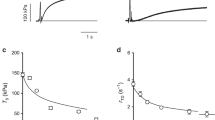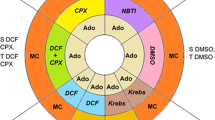Summary
The influence of vanadate (NH4VO3, Na3VO4) and vanadyl (VOSO4) on myocardial function was studied using a variety ofin vivo andex vivo cardiac preparations. In addition, the influence of vanadate on a variety of cardiac subcellular systems was examinedin vitro.
In isolated ventricular and atrial muscle of dog, cat, guinea pig, rabbit and rat, vanadate produces a positive inotropic effect. The effective concentration for positive inotropy in these tissues ranged from 10 to 500 μM. Vanadyl sulfate was less effective than either sodium ortho-vanadate or ammonium meta-vanadate. Vanadate produced negative inotropic effects in guinea pig and cat isolated left atrium, at concentrations lower than those required to produce positive inotropic effects in sensitive species and tissues.
In blood perfused papillary muscle or whole heart, or in whole animal (anesthetized or conscious), vanadate generally reduced ventricular performance and produced a marked peripheral and coronary vasoconstriction. Vanadate also contracted isolated poocine coronary artery strips, an effect similar to that produced by ouabain.
Vanadate caused a variety of effects on isolated subcellular systems of cardiac muscle. Low concentrations (0.1–100 μM) inhibited sarcolemmal Na+, K+-ATPase and Ca2+-ATPase, sarcoplasmic reticulum Ca2+-ATPase, Ca2+-binding to and uptake by sarcoplasmic reticulum, but stimulated hormone-sensitive adenylate cyclase. Higher concentrations of vanadate (100–1000 μM) inhibited myofibrillar ATPase, phosphorylation of troponin I, and mitochondrial ATPase.
On the basis of these effects of vanadate on cardiac subcellular systems, mechanisms by which vanadate acts on intact myocardium are proposed. Furthermore, consideration of anin vivo, regulatory role of vanadate is presented with regard to myocardial function.
Zusammenfassung
Die Wirkung von Vanadat (NH4VO3, Na3VO4) und Vanadyl (VOSO4) auf die Myokardfunktion wurde an einer Reihe von In-vivo- und In-vitro-Präparationen des Herzens untersucht, ebenso wie der Vanadateffekt auf subzelluläre kardiale Systeme.
Vanadat wirkt positiv inotrop in isolierten Ventrikeln und Vorhöfen von Hund, Katze, Meerschweinchen, Kaninchen und Ratte. Die dafür notwendigen Konzentrationen waren 10–500 μM. Vanadyl war weniger wirksam als Na3VO4 oder NH4VO3 Vanadat wirkt negativ inotrop an Meerschweinchen- und Katzenvorhofpräparaten in niedrigeren Konzentrationen als für den positiv inotropen Effekt notwendig sind.
An mit Blut perfundierten Papillarmuskeln oder Herzen sowie am narkotisierten oder nicht narkotisierten Tier reduziert Vanadat die linksventrikuläre Funktion und verursacht eine deutliche periphere und koronare Vasokonstriktion. Isolierte Koronararterienstreifen (Schwein) gehen durch Vanadat in Kontraktur über ähnlich der g-Strophanthinwirkung.
An isolierten subzellulären Systemen des Herzmuskels hemmen niedrige Vanadatkonzentrationen (0.1–100 μM) die sarkolemmale Na+, K+-ATPase, die Ca++-ATPase des sarkoplasmatischen Retikulums sowie dessen Ca++-Bindung und Ca++-Aufnahme. Andererseits wird die kardiale Adenylatzyklase stimuliert. Höhere Vanadatkonzentrationen (100–1000 μM) hemmen die myofibrilläre ATPase, die Phosphorylation von Troponin I und die mitochondriale ATPase.
Auf der Basis der verschiedenen Wirkungen des Vanadats werden die Mechanismen zur Diskussion gestellt, über die Vanadat am intakten Herzen wirken könnte. Außerdem wird die mögliche regulatorische Rolle des Vanadats in vivo in Hinsicht auf die Myokardfunktion beurteilt.
Similar content being viewed by others
References
Adams, R. J., A. Schwartz: Purification and Characterization of Cardiac Sarcolemma: Effects of Vanadate on Na,K-ATPase and Ca-ATPase. Fed. Proc.39, 979 (1980).
Borchard, U., A. A. L. Fox, K. Greeff, P. Schlieper: Negative and Positive Inotropic Action of Vanadate on Atrial and Ventricular Myocardium. Nature279, 339–341 (1979).
Braunwald, E., J. Ross Jr.,E. H. Sonnenblick: Mechanisms of Contraction of the Normal and Failing Heart. p. 339 (Boston 1976).
Cantley, L. C., Jr.,L. G. Cantley, L. Josephson: A Characterization of Vanadate Interaction with the (Na, K)-ATPase. J. Biol. Chem.253, 7361–7368 (1978).
Cubicciotti, R. S., C. L. Johnson: Effect of Vanadate on Guinea Pig Ventricle Adenylate Cyclase. Pharmacologist21, 248 (1979).
DiPolo, R., H. R. Rojas, L. Beaugé: Vanadate Inhibits Uncoupled Ca Efflux but Not Na−Ca Exchange in Squid Axons. Nature281, 228–229 (1979).
Erdmann, E., W. Krawietz, G. Philipp, I. Hackbarth, W. Schmitz, H. Scholz: Stimulatory Effect of Vanadate on (Na++K+-ATPase Activity and on3H-ouabain-binding in a Cat Heart Cell Membrane Preparation. Nature,278, 539–540 (1979).
Erdmann, E., W. Krawietz, G. Philipp, I. Hackbarth, W. Schmitz, H. Scholz, F. L. Crane: Purified Cardiac Cell Membranes with High (Na++K+)ATPase Activity Contain Significant NADH Vanadate Reductase Activity. Nature282, 335–336 (1979).
Gamgee, A., L. Larmuth: On the Action of Vanadium upon the Intrinsic Nervous Mechanism of the Frog's Heart. J. Anat. Physiol.II, 235–250 (1876).
Grupp, G., I. Grupp, C. L. Johnson, E. T. Wallick, A. Schwartz: Effects of Vanadate on Cardiac Contraction and Adenylate Cyclase. Biochem. Biophys. Res. Commun.88, 440–447 (1979).
Hackbarth, I., W. Schmitz, H. Scholz, E. Erdmann, W. Krawietz, G. Philipp: Positive Inotropism of Vanadate in Cat Papillary Muscle. Nature275, 67 (1978).
Hudgins, P. M., G. H. Bond: Reversal of Vanadate Inhibition of Na,K-ATPase by Catecholamines. Res. Commun. Chem. Path. Pharmacol.23, 313–326 (1979).
Inciarte, D. J., R. P. Steffen, B. T. Swindall, J. R. Johnston, D. E. Dobbins, F. J. Haddy: Effects of Intravenously Infused Vanadate on the Circulation of the Anesthetized Dog. Fed. Proc.38, 1036 (1979).
Jackson, D. E.: The Pharmacological Action of Vanadium. J. Pharmacol. Exp. Therap.3, 477–514 (1912).
O'Neal, S. G., D. B. Rhoads, E. Racker: Vanadate Inhibition of Sarcoplasmic Reticulum Ca2+-ATPase and Other ATPases Biochem. Biophys. Res. Commun.89, 845–850 (1979).
Schmitz, W., I. Hackbarth, H. Scholz: Effect of Vanadate on Force of Contraction in Mammalian Cardiac Muscle. Naunyn-Schmiedeberg's Arch. Pharmacol.307 R37 (1979).
Schwartz, A.: Doctoral Dissertation, State University of New York (1960).
Solaro, R. J., M. J. Holroyde, J. W. Herzig, J. Peterson: Cardiac Relaxation and Myofibrillar Interactions with Phosphate and Vanadate. Eur. J. Cardiol., 1980 (in press).
Solaro, R. J., M. J. Holroyde, I. Grupp, G. Grupp: Unpublished results.
Wallick, E. T., L. K. Lane, A. Schwartz: REgulation by Vanadate of Ouabain Binding to (Na+, K+)-ATPase. J. Biol. Chem.254, 8107–8109 (1979).
Wang, T., L.-I., Tsai, R. J. Solaro, A. O. G. Gende, A. Schwartz: Effects of Potassium on Vanadate Inhibition of Sarcoplasmic Reticulum Ca2+-ATPase from Dog Cardiac and Rabbit Skeletal Muscle. Biochem. Biophys. Res. Commun.91, 357–361 (1979).
Author information
Authors and Affiliations
Additional information
With 1 figure
This work was supported by United States Public Health Service Grants P01 HL 22619-01 (A.S.), ROI HL 23558-01 (R.W.M.), F32 HL 05802-02 (R.J.A.) and T32 HL 07382 (A.S.).
Rights and permissions
About this article
Cite this article
Schwartz, A., Adams, R.J., Grupp, I. et al. Effects of vanadate on myocardial function. Basic Res Cardiol 75, 444–451 (1980). https://doi.org/10.1007/BF01908409
Issue Date:
DOI: https://doi.org/10.1007/BF01908409




